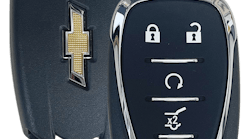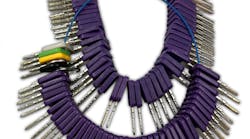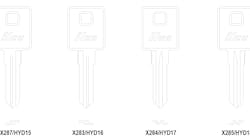"The new ML System is a patent-pending Key Control product. It is not high security and does not offer increased pick or drill resistance." This is the opening sentence from a September 2003 update of the Master Lock Technical Manual.
At the heart of the ML System is a new keyway plus a lock plug that contains holes drilled at approximately right angles to the vertical keyway. Two rounded grooves are milled inside the cylinder housing, one groove on each side of the keyway. Both grooves are milled along the entire length of the housing. Two 3/32" ball bearings are inserted into each of the drilled holes in the lock plug during final assembly.
As an ML key blank is inserted into the lock plug, the sets of ball bearings are moved outward into the grooves in the cylinder wall. The ball bearings form a second locking system and the plug is prevented from turning even if the key cuts correctly align the pin tumblers at the shearline. The ML System requires dimple cuts to be made at the same location as the ball bearings. When an ML key with proper tumbler and dimple cuts is inserted, the ball bearings can freely move into the dimpled areas as the key begins to be turned, and the lock can be opened.
Master Lock refers to each set of dimple positions as a "virtual keyway section." Reportedly about 70 different virtual keyways can be made.
ML System cylinders are available in both a four-pin and six-pin version. The shorter four-pin version will obviously have less dimple positions and less virtual keyways. ML System locks have eight possible depth increments which can produce 4096 possible code combinations for four-pin locks and 262,144 possible combinations for six-pin locks. Multiply possible combinations by the amount of virtual keyways and totals are quite staggering when compared to a standard key system.
Application for ML patents was made in 2003. Government regulations now allow an approved patent to be in force for 20 years, starting when the patent application was submitted. When accepted, the ML patent should be in force until 2023.
Master Lock has established the following four levels of key control.
Level 1 is for ML locks that are available from distributors. Locksmiths can purchase Master ML System lock products as needed. Any additional duplicate keys required in the future would be ordered from the distributor. Uncut key blanks are not available. A contractual agreement is not required.
Level 2 is designed for retail locksmiths. The locksmith is assigned one of the virtual keyways. The locksmith can order uncut key blanks with that specific virtual keyway, which are automatically stamped with a special six-character ID number. A contractual agreement and an initial amount of purchased product are required.
Level 3 is designed for institutions and commercial buildings with a locksmith on staff. The customer is assigned one of the virtual keyways. The customer can order uncut key blanks with that specific virtual keyway which are automatically stamped with a special six-character ID number. A contractual agreement and an initial amount of purchased product are required.
Level 4 is factory controlled. Key blanks are not available. Key code information is kept confidential by the manufacturer. All future additions of duplicate keys or lock products will be by factory order.
SERVICING THE ML CYLINDER
Depth and space dimensions are identical to the present 6000K and 7000K keyways.
Spacing: 187-312-437-562-687-812
Depths: 0.) 285 1.) 269 2.) 254 3.) 238 4.) 223 5.) 207 6.) 192 7.) 176
Pins in Master pin kits have the following colors:
0.) black 1.) purple 2.) red 3.) blue 4.) gold 5.) green 6.) brown 7.) black
Original Master lock cylinders can be easily repinned by turning the plug 180 degrees, then removing the old pins through existing holes drilled in the bottom of the cylinder housing. ML cylinder housings also have drilled holes, but the ball bearings are locked into the key dimples, preventing keys from being removed or inserted while the plug is turned. The solution is to remove the plug from the housing whenever cylinder servicing is required. An easily removable 'C' clip retains the lock plug in the housing. Master Lock makes a special follower which simplifies plug removal.
Ball bearings can cause a problem during repinning. There are four small ball bearings, two on each side. When removing the plug from the housing, always keep a finger on each side of the plug to hold the bearings in place as the plug is removed. A technician at Master Lock was consulted and agreed that putting a small dab of Vaseline on the ball bearings during reassembly was acceptable. This will serve to hold the ball bearings in place while re-inserting the lock plug into the housing. If a bearing gets misplaced, extra bearings are included in the ML #291 keying kit or a common 3/32" ball bearing can be substituted.
Large master key systems can also be generated. Tolerances of ML cylinders are reportedly tight enough to allow Master Lock to use single-step progression for master keying even though the increment between cuts is just .0155". The only stipulation is that no '1' master pins are used. These pin tumblers are rather thin and may catch in the rounded grooves milled into the sidewalls of the housing as the key is turned. According to Master Lock, a potential of 40,000 change keys could be generated for a single master key system. The maximum adjacent cut (MAC) is 6.
The available CK number choices are:
MK- CK cuts
0- 234567
1- 34567
2- 04567
3- 01567
4- 01267
5- 01237
6- 01234
7- 012345
Spool-shaped drivers are used in all but one chamber which does help to deter picking, but Master Lock stresses key control as the most important element of the ML design. While ML customers may have the same basic key blank, they will have key control due to differences in positioning of the dimple cuts.
One question brought up at a Master Lock ML training seminar centered on the possibility that a locksmith could drill extra dimple cuts on an ML blank in order to operate ball bearings in another virtual keyway. The instructor answered that each Level 2 and Level 3 key blank is marked with a specific ID code number which is traceable to the dealer who ordered the ML key blanks. If a double-drilled ML key is discovered, the locksmith company or commercial account that was assigned that ID number will be immediately removed from the program by Master Lock.
ML System lock cylinders may be ordered in a four-pin version as part of the laminated padlock line or in a six-pin version for all Master ProSeries padlocks. Individual ML cylinders can be ordered using a 'UN' designation which means they will be pinned with all '0' depths but will not be supplied with keys. The ML System is available as a commercial product only sold through the locksmith and industrial distributor.
For more information, contact your local locksmith distributor or:
Master Lock Company
Tel: 414-571-5625
Web: http://www.masterlock.com





